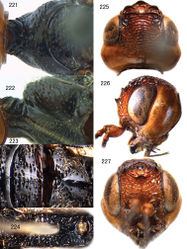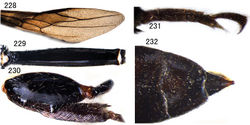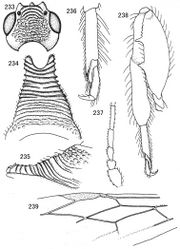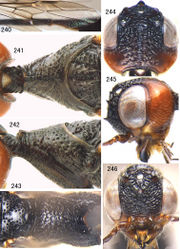Megischus
| Notice: | This page is derived from the original publication listed below, whose author(s) should always be credited. Further contributors may edit and improve the content of this page and, consequently, need to be credited as well (see page history). Any assessment of factual correctness requires a careful review of the original article as well as of subsequent contributions.
If you are uncertain whether your planned contribution is correct or not, we suggest that you use the associated discussion page instead of editing the page directly. This page should be cited as follows (rationale):
Citation formats to copy and paste
BibTeX: @article{Hong2011ZooKeys110, RIS/ Endnote: TY - JOUR Wikipedia/ Citizendium: <ref name="Hong2011ZooKeys110">{{Citation See also the citation download page at the journal. |
Ordo: Hymenoptera
Familia: Stephanidae
Name
Megischus Brullé, 1846 – Wikispecies link – Pensoft Profile
- Megischus Brullé 1846[1]: 537. Type species (designated by Viereck 1914[2]): Megischus annulator Brullé 1846[1] [= Megischus furcatus (Lepeletier & Serville, 1835)].
- Megischus aplicatus Honget al. 2010: 61.
- Megischus ruficeps Saussure: Chao 1964[3]: 378–379, 387–388, Figs II (1–2), IV (13); Belokobylskij 1995: 22.
- Megischus chaoi van Achterberg: van Achterberg and Yang 2004[4]: 109, 111–112; Hong et al. 2010[5]: 61.
- Megischus ptosimae Chao 1964[3]: 378–379, 387–388, Figs I (1), II (3–4), IV (14), V (6, 10); van Achterberg and Yang 2004[4]: 112–115; Hong et al. 2010[5]: 61.
Diagnosis
Temple without pale yellowish streak along eye, at most with a ventral patch (Figs 226, 245); pronotum robust and without transverse protuberance; vein 1-SR of fore wing differentiated with first discal cell present because of presence of vein 1-SR+M; vein 1-M of fore wing straight or nearly so; first subdiscal cell of fore wing comparatively narrow basally (Figs 228, 239, 240); hind wing without trace of vein cu-a; hind femur largely smooth and with some punctures, ventrally with 2 large teeth (Figs 230, 238, 247, 251); inner side of hind tibia usually with wide submedial depression (Fig. 248); outer side of hind tibia without oblique striae or rugulosity and ventrally evenly rounded (Fig. 249); hind tarsus of female with three tarsomeres (Fig. 238); ovipositor sheath with ivory subapical band (Fig. 250).
Distribution
Cosmopolitan.
Notes
Before this study, 83 species in the genus Megischus were known worldwide, of which 3 species were known from China. In this paper, these three species of the genus are listed from China. A key to species of the genus Megischus from China is as follows:
Key to species of the genus Megischus from China
(after Hong et al. 2010[5])
Taxon Treatment
- Hong, C; van Achterberg, C; Xu, Z; 2011: A revision of the Chinese Stephanidae (Hymenoptera, Stephanoidea) ZooKeys, 110: 1-108. doi
Other References
- ↑ 1.0 1.1 Brullé A (1846) Histoire naturelle des Insectes. Hyménoptères. Vol. IV, Paris, p. I-VIII + 1–680.
- ↑ Viereck H (1914) Type species of the genera of ichneumon flies. Bulletin of the United States National Museum 83: I–V + 1–186.
- ↑ 3.0 3.1 Chao H (1964) Description of new species of Stephanidae (Hymenoptera, Ichneumonoidea) from South China. Acta entomologica Sinica 13 (3):376-395.
- ↑ 4.0 4.1 Achterberg C, Yang Z (2004) New species of the genera Megischus Brulléand Stephanus Jurinefrom China (Hymenoptera: Stephanoidea: Stephanidae), with a key to world species of the genus Stephanus. Zoologische Medelingen Leiden 78 (3):101-117.
- ↑ 5.0 5.1 5.2 Hong C, Achterberg C, Xu Z (2010) A new species of Megischus Brullé (Hymenoptera, Stephanidae) from China, with a key to the Chinese species. ZooKeys 69: 59–64. doi: 10.3897/zookeys.69.738
Images
|




